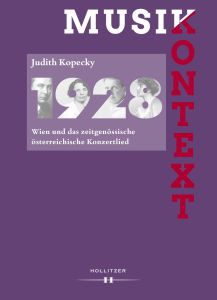Judith Kopecky, 1928. Wien und das zeitgenössische österreichische Konzertlied [1928. Vienna and the Contemporary Austrian Concert Song], Hollitzer Verlag, Vienna, 2023

Judith Kopecky’s investigation of Viennese musical life in 1928 for her dissertation project is an accomplishment of meticulous rigor. Her research focused on that era’s genre of the “concert song” (Konzertlied), under which she subsumed not only works for voice and piano but also Lied-type works accompanied by an instrumental ensemble or orchestra. Kopecky decided that her work would encompass not only the compositions themselves but also “the conditions under which they were produced, learned and rehearsed, and disseminated”—i.e., everything that surrounded them in terms of musical culture and the cultural sector.
It does indeed strike one as interesting that what the author presents us with here is not a diachronic overview of art songs during the First Austrian Republic but instead a lovingly detailed synchronous documentation of a single year within this period. Why 1928, of all years? We learn that multiple factors, ranging from the extant sources on the commemorative activities surrounding the 100th anniversary of Schubert’s death to Ernst Krenek’s return to Austria, played a role in this decision. And politically, of course, 1928 marked the exact “half-time” for the First Republic between Emperor Charles’ 1918 abdication and Austria’s annexation by the National Socialists in 1938.
In the chapter entitled “Klangwelten” [Worlds of Sound], the author describes the settings—such as Lied recitals, evenings of chamber music, and orchestral concerts as well as radio programmes—in which her works of interest were performed. The chapter “Spielräume” [Spaces of Play] features the organisers of these performances as well as the participating musicians. In “Schreibzonen” [Zones of Writing], the relevant composing activities of this period are introduced—without failing to pay attention to women composers such as Lili Hutterstrasser-Scheidl. “Gedankensphären” [Spheres of Thought] focuses on the attendant music criticism in print media as well as on the radio. And finally, a detailed listing of all public performances of contemporary Austrian Konzertlieder is included as an appendix to round out the presentation.
In all this, the author has succeeded—despite or perhaps precisely because of her focus on Austria’s modern Lied output and the limitation of her research to a single year—in making a genuine contribution to our understanding of Austrian musical life during the interwar period.

